Federal forest policy Politics and politicians Restoring cultural landscapes Saving Forests
by admin
Oregon’s Timber Supply: Steward It or Lose It
by Mike Dubrasich, Exec Dir W.I.S.E.
A talk given to the 912 Project Salem – Focus on Forestry Convention, Salem OR, May 21 2011
Good afternoon.
Thank you all very much for inviting me to join with you. My topic today is Oregon’s timber supply, and I will be sharing with you some facts and figures on timber.
For the sake of precision, timber refers to trees larger enough to be sawn into boards, and is also known as saw timber or round wood. There are numerous categories of forest products and resources in Oregon –- timber is just one of those, albeit a very important one to our economy.
In the interests of full disclosure, I am a professional forester. I have been a private consulting forester in Oregon for 30 years. I am also executive director of the Western Institute for Study of the Environment, a non-profit think tank and a collaboration of environmental scientists, resource professionals and practitioners, and the interested public. Our mission is to further advancements in environmental stewardship across a spectrum of related environmental disciplines and professions. We are ready, willing, and able to teach good stewardship and caring for the land.
Technically then, as a forester I am in the forest management industry, which is intimately associated with the forest products industry, which in turn encompasses the timber industry but also a lot more. So while I am not a timber beast, or beauty, per se, I am knowledgeable about timber and that aspect of forest management.
First let us examine some statistics regarding Oregon’s timber supply. We begin with land ownership.
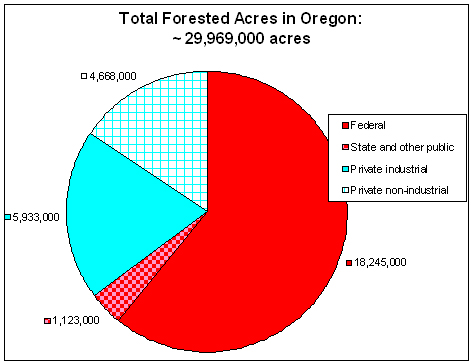
There are nearly 30 million acres of forestland in Oregon (about half the state). Nearly two-thirds (64.6 percent) of Oregon’s forestland is owned by the government, principally the Feds (60.9 percent). Private industrialists own nearly 6 million acres, or about 20 percent of the total. Private non-industrial landowners (small woodland owners, family tree farmers, rural residents) own four and a half million acres or about 16 percent of the total forestland in the state.
An estimate of the standing timber volume on that land.
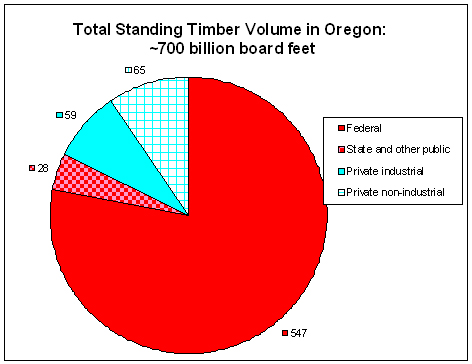
This estimate is based on a variety of not very reliable tallies, but it is in the ballpark. Approximately 700 billion board feet. Note that 75 to 80 percent of the standing timber in Oregon is on Federal land.
For valuation purposes, a board foot is a piece of wood 12 inches by 12 inches and one inch thick. Standing timber is harvested as sawlogs, trucked to a sawmill, sawn into boards, dried, packaged, and shipped to lumber yards, and thence to construction sites, and built into homes and other structures. All that value-added manufacturing, the jobs, the multiplier effect as those workers spend their earnings, makes an Oregon board foot worth (to the greater economy) from 1 to 5 dollars each, depending on which economist you consult. Using a conservative value of 1 dollar per board foot, you can easily convert 700 billion board feet to 700 billion dollars, the approximate worth of the standing timber in Oregon today.
This slide displays an estimate of the annual growth of timber in Oregon, about 11 billion board feet per year. Again, about two-thirds of the annual growth occurs on government land.
This slide shows the annual timber harvest in Oregon in 2009. 2.75 billion board feet were harvested (conservatively worth 2.75 billion dollars to the economy) which represent roughly a quarter of the annual timber growth — and none of the standing volume. The standing volume in the aggregate increased by some 8 billion board feet in 2009.
Note that about 12 percent of the harvest came from Federal lands, even though Federal lands are 60 percent of the total forested acres and contain 75 to 80 percent of the standing timber.
Why is this the case? Why is 60 percent of the forestland base, containing 75 to 80 percent of the standing timber, producing only 10 percent of the harvest? Indeed the Feds are harvesting less than 5 percent of their annual growth alone.
During the 1980’s the Feds cut around 4 billion board feet per year, still only half of their annual growth. But today they harvest only a token amount, 5 percent of growth – from 18 million acres of the most productive forest lands in the world!
Indeed the Feds burn up more timber than they harvest, a lot more, from 10 to thirty times more, each year – over the last nine years an average of 300,000 acres and as much as 9 billion board feet annually.
Up in smoke. Of course the value lost was far in excess of 9 billion dollars, from 10 to 20 times that much in resource damages. We will come back to this point.
Why? Why have the principal Federal landowners, the US Forest Service and BLM, have adopted a forest management policy of No Touch, Let It Burn, Watch It Rot.
The reasons they have done so are complex, but the root causes are political: the Endangered Species Act and a passel of similar laws, junk science driving even junkier policies, endless lawsuits brought by neo-eco-terrorists, lawsuits invited and paid for by the billions of dollars, by taxpayers, through the facetiously named Equal Access to Justice Act, the UN’s Agenda 21 and various unconstitutional treaties and “protocols” agreed to by Congress, crony capitalists who profit when Federal forest burn down, corrupt officials, corrupt institutions, etc. etc. all prodded by a multi-billion-dollar enviro alarmist industry, or political movement, or neo-religion, or whatever you want to call the mass insanity promoted by the Loony Left.
Insanity was defined by Einstein as, “doing the same thing over and over again and expecting different results. A prime example is the Northwest Forest Plan.
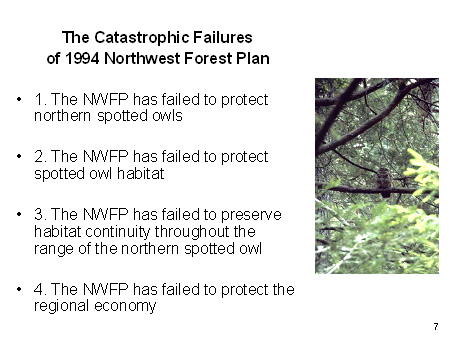
The 1994 Northwest Forest Plan is utter madness initiated by Bill Clinton, Al Gore, and the so-called Gang of Four. A now-deceased Federal judge gave his stamp of approval, called the Record of Decision or ROD.
The 1994 Northwest Forest Plan had (has) four fundamental goals. It has failed spectacularly to meet any of them.
1. The NWFP has failed to protect northern spotted owls — By most estimation, the northern spotted owl population has fallen 40 to 60 percent since inception of the NWFP.
2. The NWFP has failed to protect spotted owl habitat — Since inception, millions of acres of spotted owl habitat have been catastrophically incinerated. Millions more acres are poised to burn.
3. The NWFP has failed to preserve habitat continuity throughout the range of the northern spotted owl — The dozens of huge and catastrophic forest fires have left giant gaps in the range. The Biscuit Burn alone is 50 miles long and 20 miles wide.
4. The NWFP has failed to protect the regional economy — Since inception of the NWFP, Oregon has experienced 16 long years of the worst economy in the U.S., with the highest rates of unemployment, business bankruptcy, home foreclosure, and hunger of any state. Those are not just statistics, but indicators of real human suffering. Over 40,000 workers lost their jobs, and the rural economy has been crippled ever since.
The plan to save the owls has not saved anything; not owls, not old-growth, not the economy. The cost for nothing? $100,000 per job per year times 40,000 jobs times 16 years = $64 billion. Another way to look at it is 4 billion board feet of harvest per year, worth 4 billion dollars, times 16 years equals $64 billion. That’s what Northwesterners have paid, for nothing. And the bills continue to mount.
As a direct result, PNW Fed forests have accumulated biomass (fuels) in excess of 10 times historical levels. And as a direct result, wildfires have raged. Those fires in a-historical accumulated fuels were not light-burning and low running like fires of the past. Instead our forest fires are now a-historically severe and catastrophic.
In recent years mega-fires (those greater than 100,000 acres) have repeatedly spread from unkempt, unmanaged, fuel-laden Federal land to private land, and even into towns and cities, wreaking tens of $billions in damages every year across the West.
In 2002 the Biscuit Fire burned 500,000 acres, the largest fire in state history. It was a Let It Burn fire that blew up into an inferno. The Biscuit Fire fried the vegetation, including old growth trees, and caused extreme erosion — soil was sucked up into fire plumes and blown off the site as well as eroded directly into the Chetco River — leaving only a rubble of heavier stones behind.
The Biscuit Fire also became the most expensive fire to fight in US history at 150 million dollars. But the cost was minimal compared to the damages — over 5 billion board feet (5 billion dollars worth) of timber was destroyed. Add to that that enormous price the accumulated losses of wildlife (75 spotted owl pairs killed), losses of habitat, of historical and cultural resources, of water quality and quantity, of air quality, of public health and safety, and of recreation and scenery, all of which also impact our economy.
Other recent Oregon holocausts include the B&B Complex Fires (2003) at 90,000 acres. The B&B Fire was one of 13 large fires in the last nine years that burned 160,000 acres of that national forest. The Egley Fire in 2007 burned 140,000 acres in Harney County. On the Western Institute web sites we track large fires, over 80 in Oregon over the last five years alone, including the Tumblebug Fire, the Rattle Fire, the Oak Flat Fire, the Boze Fire, the Lonesome Fire, the North Fork Fire, the Williams Creek Fire, the Bridge Creek Fire, and dozens and dozens more, many of them Let It Burn fires in heavy fuels –- such as spotted owl nesting stands.
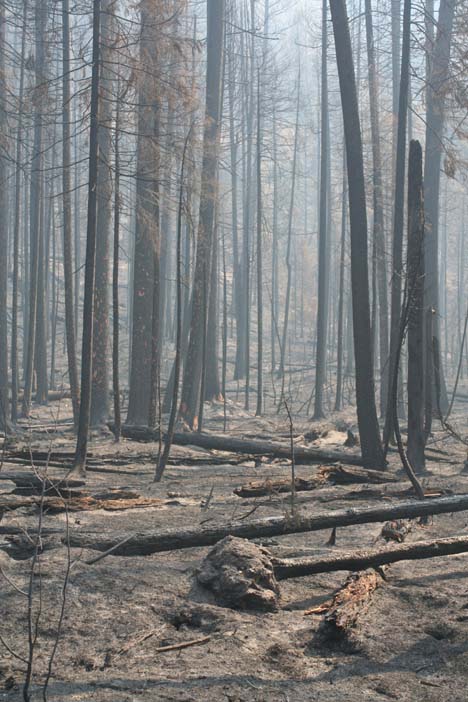
Many national forests in Oregon have adopted Let It Burn into their management plans – illegally I might add. Let It Burn goes by various aliases these days: wildfire use, prescribed natural fire, natural ignitions allowed to burn to achieve resource objectives, fire used for resource benefit, etc. That last one is a real hoot because the alleged (imaginary) benefits of catastrophic fire have never been elucidated by the Loony Left advocates of forest incineration, while the real damages have been professionally appraised in the tens of billions.
The outlook is indeed bleak. There has been a War on the West going on for many decades. We, the residents and hence targets of that war, are losing. The forces arrayed against us seek to destroy our economy by destroying our livelihoods. Oregon is a natural resource producer and wealth creator state, and hence our natural resources have been locked away to burn – as punishment to the citizenry, evidently, for being human. However, the eco-religious taboos against humanity in nature do not serve nature, either.
As hopeless and dark as the situation seems, there are some rays of light out there.
There are signs of renaissance appearing. Some might call it a step backward, a recession, but I call it a rebirth, a renaissance of traditional environmental stewardship values.
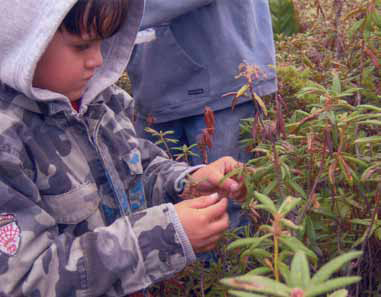
Mankind has always been caretaker of nature, the keystone predator, and the only animal to control fire — with weapons and fire the prime movers and main influences in the landscape — for all of our species existence and for as long as we have been in any particular place. In Oregon human beings have been resident here for at least 15,500 years.
Over the millennia of the Holocene, the human residents of this truly ancient homeland had enormous influences on the environment and controlled the prevalence and distribution of hundreds of plant and animal species.
One sign of renaissance is in the new understandings of human heritage and history in Oregon. It is paralleled by new understandings of forest ecology, a paradigm shift in that science. The establishment ecology today is more of a religion than a science, but that is changing. A few brave, insightful, and truly science-minded ecologists are challenging the shibboleths.
Among the new findings: many (if not most) North American forests were at one time (prior to ~120 years ago) open and park-like, with widely spaced, large, old trees. Forests were conditioned to be that way by frequent, non-stand-replacing, anthropogenic — human set — fires.
Several lines of evidence suggest that the prairies, savannas, and open forests have been persistent vegetation types in Oregon for the last few thousand years, at least. Forest development pathways were mediated by frequent, purposeful, anthropogenic fires deliberately set by skilled practitioners, informed by long cultural experience and traditional ecological knowledge in order to achieve specific land management objectives. At a landscape scale the result was maintenance of an (ancient) anthropogenic mosaic of agro-ecological patches.
In the absence, over the last 150 years, of purposeful anthropogenic fires, the anthropogenic mosaic has been invaded and obscured by (principally) Douglas-fir. As a result, much of our public forestland is now burdened with biomass ten times the historical loadings and are at risk from a-historical, catastrophic, stand-replacing fires.
Our old-growth trees arose under much different conditions than today. The forest development pathways of pre-Contact eras were not punctuated by catastrophic stand-replacing fires but instead were the outcomes of frequent, seasonal, light-burning fires in open, park-like forests. Those fires were largely anthropogenic (human-set by the indigenous residents). Because the fires of historic eras were frequent and seasonal, they gently removed fuels without killing all the trees. The widely-spaced trees thus survived repeated burning and grew to very old ages.
Modern fires, especially those in dense thickets that are no longer managed by frequent, seasonal, anthropogenic fires, cause total tree mortality. No trees survive the infrequent holocausts, and so no trees attain old-growth status. In fact, modern fires routinely kill old-growth trees that withstood multiple fires in bygone eras. Modern fires, burning in dense, build-up fuel conditions, are severe and often convert heritage forests to more or less permanent brush fields.
One sign of incipient renaissance is the effort to restore traditional stewardship through forest restoration — to restore, maintain, and perpetuate the historical patterns of prairies (meadows), and savannas (woodlands) that existed prior to Euro-American occupation. By restoring thicket forests to their historical norm of open, park-like conditions, and in addition by restoring historical anthropogenic fire regimes, forests can be saved from catastrophic incineration and conversion to brush.
Forest restoration also requires a reduction in the existing standing volume of 80 to 90 percent – back to historical levels. We ought to be harvesting growth plus standing timber volume every year from Federal forests – for forest health and wildlife purposes. To restore fire resilient habitat, we must first remove the fuels, at a rate of 10 billion board feet or more per year, in Oregon alone from Federal forests alone, for the next few decades. Sooner is better than later because later might be too late.
An annual harvest of ten billion board feet from Federal forests in Oregon would mean ten billion dollars per year injected into Oregon’s economy for the next few decades. The reduction in damages from catastrophic forest fires would be an additional economic benefit worth billions of dollars per year.
It would take 100 years at that rate to restore those forests to historical biomass levels. If and when that occurs, the harvest rate might be reduced to growth only — about six billion board feet per year.
Douglas-fir will continue to be prevalent and grow rapidly, but the forest product mix might eventually run more to fibers of other species, rather than Douglas-fir timber. Many of those other products are more valuable –- they produce more dollars per acre per year for equivalent or lesser investment. The Indians did not use Douglas-fir for much but firewood. They favored other species for fiber, such as western red cedar, beargrass, and hazel, which are more profitable to grow than Douglas-fir today as well in the distant past.
There is also a renaissance in the socio-political arena, exemplified by the 912 Project and other manifestations of the Tea Party and the growing conservative movement. That renaissance is a rebirth of traditional values: of family values, pro-human being, pro-limited government, for unalienable human rights, life, liberty, property, self-reliance, independence, rule of law made by democratic processes, not by imperial decree, for local control over our own lives, livelihoods, and landscapes.
Environmental stewardship is a traditional value. We have always been the caretakers of the planet. It is our unalienable birthright and our birth responsibility to tend to this world. The renaissance in traditional values must include traditional environmental values as well. People belong in the landscape, not evicted from it by the locked gates of the empire and imperial catastrophic fires.
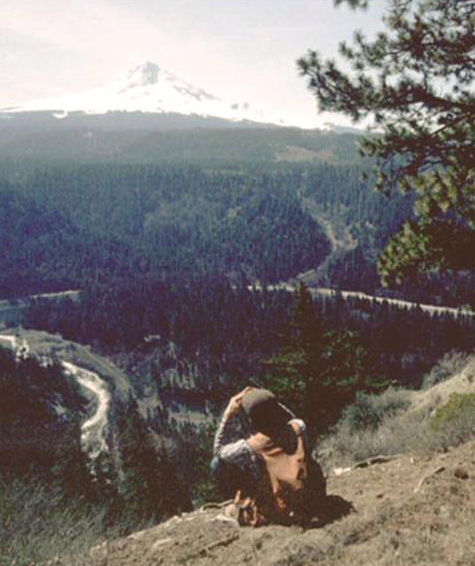
In closing, please allow me to compliment you on your realization that this country needs a renaissance in traditional values, and to salute you on your efforts to forge a new socio-political unity to further that cause.
May I suggest that conservative conservationism, environmental realism, and traditional stewardship values have a place in your platform.
There are hundreds (possibly thousands) of organizations, websites, blogs, and engaged individuals who share a passion for responsible environmental stewardship. Many small (and some big), localized, sometimes single-issue groups fall under the common headings of “environmental realism” or “conservative conservation”. They are often isolated and not connected with each other or across disciplines. All share common goals, however, of good science, good stewardship, and good government.
One of our goals should be to unite our natural allies: foresters, farmers, ranchers, hunters, fishermen, climate realists, energy realists, wildfire realists, private property rights advocates, and other factions of conservative conservation.
Political power grows through organization, through networking, through events like this one that unite us through our shared values.
Thank you very sincerely for this opportunity to participate in this conservative renaissance gathering.
Mike:
Excellent essay, background, graphs, and points.
I hope there will be a wider distribution for this work than just your presentation and this posting.
People — especially people interested in forestry in the western US — need to see and consider this information and these ideas.
by TLM
Excellent!
Thanks, Mike. I wish every legislator in Oregon would read this.
Posted to my Facebook group. Very comprehensive and chock-full of “inconvenient science” and evidence showing the results of “re-wilding” and radical preservationism.
by Greg
Excellent presentation. Like a 2×4 up the side of the head. I wish every FS employee, Legislator, and Forester in the country would read this.
Conservatives need an ecological/natural resource management plank in their platform and it is not too late to add one. You have just supplied some sorely needed nails. This is an issue conservative candidates can win with.
by Restoring the legacy of our forests » One Voice for Working Forests
[...] Study of the Environment, gave a speech recently about federal forest policy and posted the text of the speech [...]
by TreeC123
You says: “Forest restoration also requires a reduction in the existing standing volume of 80 to 90 percent – back to historical levels.”
This is misusing the concept of “standing volume” and missing important aspects relating to biomass. Standing volume is a grossly inadequate measure of forest health. In fact, it’s a good thing we are growing more than we are logging on federal lands, because it is helping to grow back some of the millions of tons of carbon that was depleted during the old growth clearcutting binge.
Through 1990, more than 1.5 billion metric tons of net carbon emissions were caused by the conversion of old growth forests to short rotation forestry in western Washington and western Oregon. This region represent only .017% of global land area but emitted an astounding 2% of global carbon emissions from land use. Put another way … in the century preceding 1990 the logging binge on the westside of Oregon and Washington caused 100 times more carbon emissions from land use activities compared to the global average for similar sized areas. Harmon, M., Ferrell, W., and J. Franklin. 1990. Effects on Carbon Storage of Conversion of Old-Growth to Young Forests. Science. 9 February 1990.
Reply: Tree, you missed the point utterly. Current biomass levels are 10 times the historical levels from before any logging occurred. There is a pernicious myth installed in your brain that tells you there was more volume in prior eras. Wrong. Very wrong. During the last ~100,000 years there has never been more biomass/volume/fixed carbon in our forests than there is today. Despite your so-called “clearcutting binge”.
Harmon and Franklin are ignorant of forest history. Very ignorant. Dumber than rocks.
PS — Carbon dioxide, a trace gas, does not affect temperatures. If it did, which it doesn’t, we should encourage more of it because WARMER IS BETTER!!!

sweet.